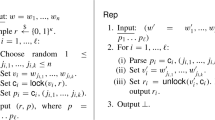Abstract
Fuzzy extractor converts the reading of a noisy non-uniform source to a reproducible and almost uniform output \(\mathsf {R}\). The output \(\mathsf {R}\) in turn is used in some cryptographic system as a secret key. To enable multiple extractions of keys \(\mathsf {R}_1, \mathsf {R}_2, \ldots , \mathsf {R}_\rho \) from the same noisy non-uniform source and applications of different \(\mathsf {R}_i\), the concept of reusable fuzzy extractor is proposed to guarantee the pseudorandomness of \(\mathsf {R}_i\) even conditioned on other extracted keys \(\mathsf {R}_j\) (from the same source).
In this work, we construct a reusable fuzzy extractor from the Learning With Errors (LWE) assumption. Our reusable fuzzy extractor provides resilience to linear fraction of errors. Moreover, our construction is simple and efficient and imposes no special requirement on the statistical structure of the multiple readings of the source.
Access this chapter
Tax calculation will be finalised at checkout
Purchases are for personal use only
Similar content being viewed by others
References
Agrawal, S., Boneh, D., Boyen, X.: Efficient lattice (H)IBE in the standard model. In: Gilbert, H. (ed.) EUROCRYPT 2010. LNCS, vol. 6110, pp. 553–572. Springer, Heidelberg (2010). https://doi.org/10.1007/978-3-642-13190-5_28
Alamélou, Q., Berthier, P.E., Cachet, C., Cauchie, S., Fuller, B., Gaborit, P., Simhadri, S.: Pseudoentropic isometries: a new framework for fuzzy extractor reusability (2016). http://eprint.iacr.org/2016/1100
Apon, D., Cho, C., Eldefrawy, K., Katz, J.: Efficient, reusable fuzzy extractors from LWE. In: Dolev, S., Lodha, S. (eds.) CSCML 2017. LNCS, vol. 10332, pp. 1–18. Springer, Cham (2017). https://doi.org/10.1007/978-3-319-60080-2_1
Bennett, C.H., Brassard, G., Robert, J.: Privacy amplification by public discussion. SIAM J. Comput. 17(2), 210–229 (1988). https://doi.org/10.1137/0217014
Blanton, M., Aliasgari, M.: On the (non-)reusability of fuzzy sketches and extractors and security in the computational setting. In: Lopez, J., Samarati, P. (eds.) SECRYPT 2011, pp. 68–77. SciTePress (2011)
Blanton, M., Aliasgari, M.: Analysis of reusability of secure sketches and fuzzy extractors. IEEE Trans. Inf. Forensics Secur. 8(9), 1433–1445 (2013). https://doi.org/10.1109/TIFS.2013.2272786
Boyen, X.: Reusable cryptographic fuzzy extractors. In: Atluri, V., Pfitzmann, B., McDaniel, P.D. (eds.) CCS 2004, pp. 82–91. ACM, New York (2004). https://doi.org/10.1145/1030083.1030096
Canetti, R., Fuller, B., Paneth, O., Reyzin, L., Smith, A.: Reusable fuzzy extractors for low-entropy distributions. In: Fischlin, M., Coron, J.-S. (eds.) EUROCRYPT 2016. LNCS, vol. 9665, pp. 117–146. Springer, Heidelberg (2016). https://doi.org/10.1007/978-3-662-49890-3_5
Dodis, Y., Ostrovsky, R., Reyzin, L., Smith, A.D.: Fuzzy extractors: how to generate strong keys from biometrics and other noisy data. SIAM J. Comput. 38(1), 97–139 (2008)
Dodis, Y., Reyzin, L., Smith, A.: Fuzzy extractors: how to generate strong keys from biometrics and other noisy data. In: Cachin, C., Camenisch, J. (eds.) EUROCRYPT 2004. LNCS, vol. 3027, pp. 523–540. Springer, Heidelberg (2004). https://doi.org/10.1007/978-3-540-24676-3_31
Fuller, B., Meng, X., Reyzin, L.: Computational fuzzy extractors. In: Sako, K., Sarkar, P. (eds.) ASIACRYPT 2013. LNCS, vol. 8269, pp. 174–193. Springer, Heidelberg (2013). https://doi.org/10.1007/978-3-642-42033-7_10
Peikert, C., Vaikuntanathan, V., Waters, B.: A framework for efficient and composable oblivious transfer. In: Wagner, D. (ed.) CRYPTO 2008. LNCS, vol. 5157, pp. 554–571. Springer, Heidelberg (2008). https://doi.org/10.1007/978-3-540-85174-5_31
Regev, O.: On lattices, learning with errors, random linear codes, and cryptography. In: Gabow, H.N., Fagin, R. (eds.) STOC 2005, pp. 84–93. ACM, New York (2005). https://doi.org/10.1145/1060590.1060603
Regev, O.: The learning with errors problem (invited survey). In: CCC 2010, pp. 191–204. IEEE Computer Society (2010). https://doi.org/10.1109/CCC.2010.26
Shoup, V.: A Computational Introduction to Number Theory and Algebra. Cambridge University Press, Cambridge (2006)
Simoens, K., Tuyls, P., Preneel, B.: Privacy weaknesses in biometric sketches. In: 30th IEEE Symposium on Security and Privacy, pp. 188–203. IEEE Computer Society (2009). https://doi.org/10.1109/SP.2009.24
Tanamoto, T., Yasuda, S., Takaya, S., Fujita, S.: Physically unclonable function using an initial waveform of ring oscillators. IEEE Trans. Circuits Syst. 64(7), 827–831 (2017). https://doi.org/10.1109/TCSII.2016.2602828
Valsesia, D., Coluccia, G., Bianchi, T., Magli, E.: User authentication via PRNU-based physical unclonable functions. IEEE Trans. Inf. Forensics Secur. 12(8), 1941–1956 (2017). https://doi.org/10.1109/TIFS.2017.2697402
Wilde, M.M.: Quantum Information Theory. Cambridge University Press, Cambridge (2017). https://doi.org/10.1017/9781316809976
Acknowledgements
This work was supported by the National Natural Science Foundation of China (NSFC No. 61672346).
Author information
Authors and Affiliations
Corresponding author
Editor information
Editors and Affiliations
Rights and permissions
Copyright information
© 2018 Springer International Publishing AG, part of Springer Nature
About this paper
Cite this paper
Wen, Y., Liu, S. (2018). Reusable Fuzzy Extractor from LWE. In: Susilo, W., Yang, G. (eds) Information Security and Privacy. ACISP 2018. Lecture Notes in Computer Science(), vol 10946. Springer, Cham. https://doi.org/10.1007/978-3-319-93638-3_2
Download citation
DOI: https://doi.org/10.1007/978-3-319-93638-3_2
Published:
Publisher Name: Springer, Cham
Print ISBN: 978-3-319-93637-6
Online ISBN: 978-3-319-93638-3
eBook Packages: Computer ScienceComputer Science (R0)




